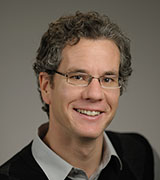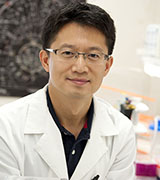Colleagues: Recently Tenured
DANIEL R. LARSON, PH.D., NCI-CCR
Senior Investigator and Head, Systems Biology of Gene Expression Section, Laboratory of Receptor Biology and Gene Expression, Center for Cancer Research, National Cancer Institute

Training: Postdoctoral fellow, Department of Anatomy and Structural Biology, Albert Einstein College of Medicine (The Bronx, New York)
Education: Ohio State University, Columbus, Ohio (B.S. in physics); Cornell University, Ithaca, New York (M.S. and Ph.D. in biophysics)
Outside interests: Hiking; gardening; swimming
Website: https://irp.nih.gov/pi/daniel-larson
Research interests: For more than 20 years, I have been using single-molecule analysis to solve biological problems in living cells. The primary goal of my laboratory is to understand gene expression in eukaryotic cells, starting from the mechanistic behavior of individual macromolecules and proceeding to their regulation in cells and tissue. I apply a biophysical approach to eukaryotic transcriptional regulation. The view that has emerged from these studies is that gene regulation is a dynamic process resulting in stochastic (random) variation within populations. It is now well known that gene-expression heterogeneity arises in large part through the fluctuations in transcriptional activity.
My lab is also developing the tools to explore both the mechanisms of RNA splicing and the consequences of stochastic RNA processing for phenotype selection and disease progression. This work on splicing factor mutations in leukemia revealed a novel pathway of translational regulation and represents a new direction for the lab but one that is a natural evolution of my overarching focus on gene expression in single cells. Ongoing work in the lab now focuses on understanding the dynamic interplay among transcription, splicing, and translation during the formation of blood cells.
JI LUO, PH.D., NCI-CCR
Senior Investigator, Laboratory of Cancer Biology and Genetics, Center for Cancer Research, National Cancer Institute

Education: University of Cambridge, Cambridge, United Kingdom (B.A. in natural sciences); Harvard University, Cambridge, Massachusetts (Ph.D. in cellular and developmental biology)
Training: Postdoctoral fellow, Department of Genetics, Harvard Medical School, Brigham and Women’s Hospital (Boston)
Came to NIH: In 2010
Outside interests: Cycling; hiking; photography; painting
Website: https://irp.nih.gov/pi/ji-luo
Research interests: My long-term research goal is to understand the biology of the RAS oncogene and identify new therapeutic strategies for RAS mutant cancers. Most of these cancers are lung, colorectal, and pancreatic adenocarcinomas that harbor mutations in one specific member of the RAS family: KRAS. The KRAS gene encodes a small GTPase protein that plays a key role in mitogenic signaling pathways that control cell growth, cell division, cell differentiation, and cell death. Currently, there are no effective targeted therapies for KRAS mutant cancers.
During my postdoctoral training, I helped discover several vulnerabilities in KRAS mutant cancer cells and develop the concept of “non-oncogene addiction.” Oncogene addiction is the dependency of certain tumor cells on oncogene-activated pathways; non-oncogene addiction is the dependency of cancer cells on non-cancer pathways such as metabolic adaptation, DNA repair, and protein homeostasis for survival. We proposed that non-oncogene addiction presents new therapeutic opportunities.
Today, my lab is particularly interested in understanding how oncogenic stress (cellular damage associated with malignant transformation) gives rise to non-oncogene addiction and synthetic lethality (a combination of alterations in two or more genes that lead to cell death) in KRAS mutant cancer cells, and how we could exploit this phenomenon to discover novel treatment paradigms. Recently, we found that KRAS mutant cells are critically dependent on the autophagy pathway for survival when mitogenic signaling is inhibited. The resulting new target-combination strategy is being evaluated in clinical trials.
In parallel, we have developed CRISPR gene-editing and pharmacological platforms to identify target and drug combinations for the effective elimination of KRAS mutant cells. We are also working closely with the NCI RAS Initiative [https://www.cancer.gov/research/key-initiatives/ras] to translate our discoveries into therapies.
JOSEPH M. ZIEGELBAUER, PH.D., NCI-CCR
Senior Investigator, HIV and AIDS Malignancy Branch, Center for Cancer Research, National Cancer Institute

Education: Cornell University, Ithaca, New York (B.S. in biology and biochemistry); University of California at Berkeley, Berkeley, California (Ph.D.)
Training: Postdoctoral fellow, Department of Microbiology, University of California at San Francisco (San Francisco, California)
Came to NIH: In 2008
Outside interests: Biking; swimming with his two children; astrophotography
Website: https://irp.nih.gov/pi/joseph-ziegelbauer
Research interests: Kaposi’s sarcoma-associated herpesvirus (KSHV) causes Kaposi’s sarcoma, the most common form of which develops in people living with HIV. My primary focus is elucidating the functions of microRNAs (miRNAs) expressed by KSHV, a human-cancer virus that expresses multiple viral miRNAs. These viral miRNAs are more abundant than human miRNAs in KSHV-infected patient-derived cell lines. I was one of the first scientists to publish a screen for viral miRNA targets using gene-expression analysis. In addition, my group published the first proteomic screen for viral miRNA targets in primary human cells, found that a human protein could cleave miRNA precursors of KSHV and Epstein-Barr virus (which causes mononucleosis, and published that a form of cholesterol can repress KSHV infection. By developing modified methods to identify dozens of miRNA target genes that are missed using standard approaches, we contributed to new insights into miRNA target discovery. We also identified the first human circular RNA that can inhibit KSHV infection, discovered viral circular RNAs, and found that some viral circular RNAs can regulate cell proliferation.
This page was last updated on Thursday, March 31, 2022
